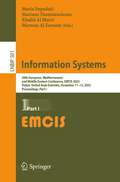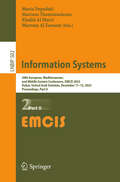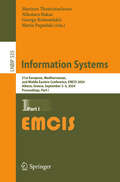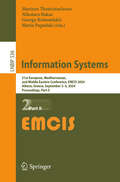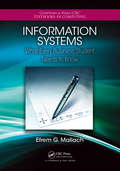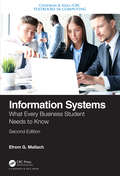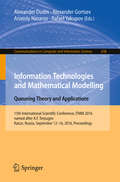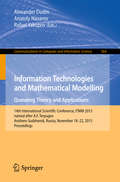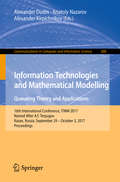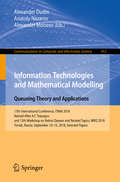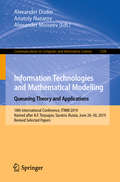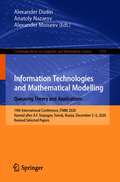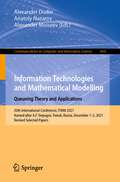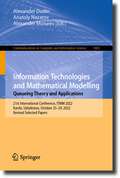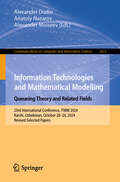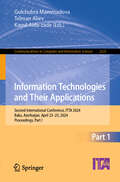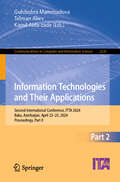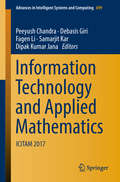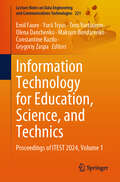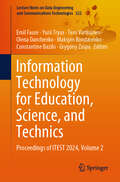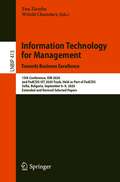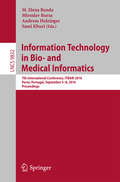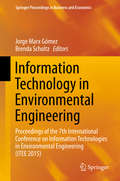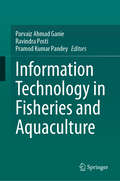- Table View
- List View
Information Systems: 20th European, Mediterranean, and Middle Eastern Conference, EMCIS 2023, Dubai, United Arab Emirates, December 11-12, 2023, Proceedings, Part I (Lecture Notes in Business Information Processing #501)
by Marinos Themistocleous Khalid Al Marri Maria Papadaki Marwan Al ZarouniThis book constitutes selected papers from the 20th European, Mediterranean, and Middle Eastern Conference, EMCIS 2023, which was held in Dubai, UAE, during December 11-12, 2023. EMCIS covers technical, organizational, business, and social issues in the application of information technology and is dedicated to the definition and establishment of Information Systems (IS) as a discipline of high impact for IS professionals and practitioners. It focuses on approaches that facilitate the identification of innovative research of significant relevance to the IS discipline following sound research methodologies that lead to results of measurable impact. The 43 papers presented in this volume were carefully reviewed and selected from a total of 126 submissions. They were organized in topical sections as follows: Part I: Metaverse; blockchain technology and applications; digital governance; healthcare information systems; artificial intelligence; Part II: Big data and analytics; digital services and social media; innovative research projects; managing information systems; smart cities.
Information Systems: 20th European, Mediterranean, and Middle Eastern Conference, EMCIS 2023, Dubai, United Arab Emirates, December 11-12, 2023, Proceedings, Part II (Lecture Notes in Business Information Processing #502)
by Marinos Themistocleous Khalid Al Marri Maria Papadaki Marwan Al ZarouniThis book constitutes selected papers from the 20th European, Mediterranean, and Middle Eastern Conference, EMCIS 2023, which was held in Dubai, UAE, during December 11-12, 2023. EMCIS covers technical, organizational, business, and social issues in the application of information technology and is dedicated to the definition and establishment of Information Systems (IS) as a discipline of high impact for IS professionals and practitioners. It focuses on approaches that facilitate the identification of innovative research of significant relevance to the IS discipline following sound research methodologies that lead to results of measurable impact. The 43 papers presented in this volume were carefully reviewed and selected from a total of 126 submissions. They were organized in topical sections as follows: Part I: Metaverse; blockchain technology and applications; digital governance; healthcare information systems; artificial intelligence; Part II: Big data and analytics; digital services and social media; innovative research projects; managing information systems; smart cities.
Information Systems: 21st European, Mediterranean, and Middle Eastern Conference, EMCIS 2024, Athens, Greece, September 2–3, 2024, Proceedings, Part I (Lecture Notes in Business Information Processing #535)
by Marinos Themistocleous Maria Papadaki Nikolaos Bakas George KokosalakisThe two-volume set LNBIP 535 + 536 constitutes selected papers from the 21st European, Mediterranean, and Middle Eastern Conference, EMCIS 2024, which was held in Athens, Greece, during September 2-3, 2024. EMCIS covers technical, organizational, business, and social issues in the application of information technology and is dedicated to the definition and establishment of Information Systems (IS) as a discipline of high impact for IS professionals and practitioners. It focuses on approaches that facilitate the identification of innovative research of significant relevance to the IS discipline following sound research methodologies that lead to results of measurable impact. The 53 papers presented in the proceedings were carefully reviewed and selected from a total of 152 submissions. They were organized in topical sections as follows: Part I: Artificial Intelligence; Blockchain Technology and Applications; Metaverse, Immersive Technologies and Games; Smart Cities; Classical and Emerging Digital Governance – The Artificial Intelligence Era; Part II: Management Information Systems; Advanced Topics in Information Systems; Core Topics in Information Systems; Information Systems Security, Information Privacy Protection and Trust Management.
Information Systems: 21st European, Mediterranean, and Middle Eastern Conference, EMCIS 2024, Athens, Greece, September 2–3, 2024, Proceedings, Part II (Lecture Notes in Business Information Processing #536)
by Marinos Themistocleous Maria Papadaki Nikolaos Bakas George KokosalakisThe two-volume set LNBIP 535 + 536 constitutes selected papers from the 21st European, Mediterranean, and Middle Eastern Conference, EMCIS 2024, which was held in Athens, Greece, during September 2-3, 2024. EMCIS covers technical, organizational, business, and social issues in the application of information technology and is dedicated to the definition and establishment of Information Systems (IS) as a discipline of high impact for IS professionals and practitioners. It focuses on approaches that facilitate the identification of innovative research of significant relevance to the IS discipline following sound research methodologies that lead to results of measurable impact. The 53 papers presented in the proceedings were carefully reviewed and selected from a total of 152 submissions. They were organized in topical sections as follows: Part I: Artificial Intelligence; Blockchain Technology and Applications; Metaverse, Immersive Technologies and Games; Smart Cities; Classical and Emerging Digital Governance – The Artificial Intelligence Era; Part II: Management Information Systems; Advanced Topics in Information Systems; Core Topics in Information Systems; Information Systems Security, Information Privacy Protection and Trust Management.
Information Systems: What Every Business Student Needs to Know (Chapman & Hall/CRC Textbooks in Computing)
by Efrem G. MallachMost information systems (IS) texts overwhelm business students with overly technical information they may not need in their careers. This textbook takes a new approach to the required IS course for business majors. For each topic covered, the text highlights key "Take-Aways" that alert students to material they will need to remember during their careers. Sections titled "Where You Fit In" and "Why This Chapter Matters" explain how the topics being covered will impact students once they are on the job. Review questions, discussion questions, and summaries are included in each chapter.
Information Systems: What Every Business Student Needs to Know, Second Edition (Chapman & Hall/CRC Textbooks in Computing)
by Efrem G. MallachMost information systems textbooks overwhelm business students with overly technical information they may not need in their careers. This textbook takes a new approach to the required information systems course for business majors. For each topic covered, the text highlights key "Take-Aways" that alert students to material they will need to remember during their careers. Sections titled "Where You Fit In" and "Why This Chapter Matters" explain how the topics being covered will impact students on the job. Review questions, discussion questions, and summaries are also included. This second edition is updated to include new technology, along with a new running case study. Key features: Single-mindedly for business students who are not technical specialists Doesn&’t try to prepare IS professionals; other courses will do that Stresses the enabling technologies and application areas that matter the most today Based on the author&’s real-world experience Up to date regarding technology and tomorrow&’s business needs This is the book the author—and, more importantly, his students—wishes he had when he started teaching. Dr. Mallach holds degrees in engineering from Princeton and MIT, and in business from Boston University. He worked in the computer industry for two decades, as Director of Strategic Planning for a major computer firm and as co-founder/CEO of a computer marketing consulting firm. He taught information systems in the University of Massachusetts (Lowell and Dartmouth) business schools for 18 years, then at Rhode Island College following his retirement. He consults in industry and serves as Webmaster for his community, in between hiking and travel with his wife.
Information Technologies and Mathematical Modelling - Queueing Theory and Applications
by Alexander Dudin Anatoly Nazarov Rafael Yakupov Alexander GortsevThis book constitutes the refereed proceedings of the 14th International Scientific Conference on Information Technologies and Mathematical Modeling, named after A. F. Terpugov, ITMM 2016, held in Katun, Russia, in September 2016. The 33 full papers presented together with 4 short papers were carefully reviewed and selected from 96 submissions. They are devoted to new results in the queueing theory and its applications, addressing specialists in probability theory, random processes, mathematical modeling as well as engineers dealing with logical and technical design and operational management of telecommunication and computer networks.
Information Technologies and Mathematical Modelling - Queueing Theory and Applications
by Alexander Dudin Anatoly Nazarov Rafael YakupovThisbook constitutes the refereed proceedings fo the 14th International Scientific Conferenceon Information Technologies and Mathematical Modeling, named after A. F. Terpugov, ITMM 2015, held in Anzhero-Sudzhensk, Russia, in November 2015. The 35 full papers included in this volume were carefully reviewedand selected from 89 submissions. They are devoted to new results in thequeueing theory and its applications, addressing specialists in probabilitytheory, random processes, mathematical modeling as well as engineers dealingwith logical and technical design and operational management oftelecommunication and computer networks.
Information Technologies and Mathematical Modelling. Queueing Theory and Applications
by Alexander Dudin Anatoly Nazarov Alexander KirpichnikovThis book constitutes the refereed proceedings of the 15th International Scientific Conference on Information Technologies and Mathematical Modeling, named after A. F. Terpugov, ITMM 2016, held in Katun, Russia, in September 2016. The 33 full papers presented together with 4 short papers were carefully reviewed and selected from 96 submissions. They are devoted to new results in the queueing theory and its applications, addressing specialists in probability theory, random processes, mathematical modeling as well as engineers dealing with logical and technical design and operational management of telecommunication and computer networks.
Information Technologies and Mathematical Modelling. Queueing Theory and Applications: 17th International Conference, ITMM 2018, Named After A.F. Terpugov, and 12th Workshop on Retrial Queues and Related Topics, WRQ 2018, Tomsk, Russia, September 10-15, 2018, Selected Papers (Communications in Computer and Information Science #912)
by Alexander Dudin Anatoly Nazarov Alexander MoiseevThis book constitutes the proceedings of the 17th International Conference on Information Technologies and Mathematical Modelling, ITMM 2018, named after A.F. Terpugov, and the 12th Workshop on Retrial Queues and Related Topics, held in Tomsk, Russia, in September 2018. The 30 papers presented in this volume were carefully reviewed and selected from 84 submissions. The conference covers various aspects of information technologies, focusing on queueing theory, stochastic processes, Markov processes, renewal theory, network performance equation and network protocols.
Information Technologies and Mathematical Modelling. Queueing Theory and Applications: 18th International Conference, ITMM 2019, Named after A.F. Terpugov, Saratov, Russia, June 26–30, 2019, Revised Selected Papers (Communications in Computer and Information Science #1109)
by Alexander Dudin Anatoly Nazarov Alexander MoiseevThis book constitutes the proceedings of the 18th International Conference on Information Technologies and Mathematical Modelling, ITMM 2019, named after A.F. Terpugov, held in Saratov, Russia, in June 2019. The 25 full papers presented in this volume were carefully reviewed and selected from 72 submissions. The conference covers various aspects of information technologies, focusing on queueing theory, stochastic processes, Markov processes, renewal theory, network performance equation and network protocols.
Information Technologies and Mathematical Modelling. Queueing Theory and Applications: 19th International Conference, ITMM 2020, Named after A.F. Terpugov, Tomsk, Russia, December 2-5, 2020, Revised Selected Papers (Communications in Computer and Information Science #1391)
by Alexander Dudin Anatoly Nazarov Alexander MoiseevThis book constitutes revised selected papers of the 19th International Conference on Information Technologies and Mathematical Modelling, ITMM 2020, named after A.F. Terpugov, held in Tomsk, Russia, in December 2020. The 31 full papers presented in this volume were carefully reviewed and selected from 82 submissions. The conference covers various aspects of information technologies, focusing on queueing theory, stochastic processes, Markov processes, renewal theory, network performance equation and network protocols.
Information Technologies and Mathematical Modelling. Queueing Theory and Applications: 20th International Conference, ITMM 2021, Named after A.F. Terpugov, Tomsk, Russia, December 1–5, 2021, Revised Selected Papers (Communications in Computer and Information Science #1605)
by Alexander Dudin Anatoly Nazarov Alexander MoiseevThis book constitutes revised selected papers of the 20th International Conference on Information Technologies and Mathematical Modelling, ITMM 2021, named after A.F. Terpugov, held in Tomsk, Russia, in December 2021. Due to the COVID-19 pandemic the conference was held in a virtual mode. The 28 full papers presented in this volume were carefully reviewed and selected from 89 submissions. The conference covers various aspects of information technologies, focusing on queueing theory, stochastic processes, Markov processes, renewal theory, network performance equation and network protocols.
Information Technologies and Mathematical Modelling. Queueing Theory and Applications: 21st International Conference, ITMM 2022, Karshi, Uzbekistan, October 25–29, 2022, Revised Selected Papers (Communications in Computer and Information Science #1803)
by Alexander Dudin Anatoly Nazarov Alexander MoiseevThis book constitutes the refereed proceedings of the 21st International Conference on Information Technologies and Mathematical Modelling. Queueing Theory and Applications, ITMM 2022, held in Karshi, Uzbekistan, during October 25–29, 2022. The 19 full papers included in this book were carefully reviewed and selected from 89 submissions. The papers are devoted to new results in queueing theory and its applications. Its target audience includes specialists in probabilistic theory, random processes, mathematical modeling as well as engineers engaged in logical and technical design and operational management of data processing systems, communication, and computer networks.
Information Technologies and Mathematical Modelling. Queueing Theory and Applications: 22nd International Conference, ITMM 2023 and 14th International Workshop, WRQ 2023, Tomsk, Russia, December 4–9, 2023, Revised Selected Papers (Communications in Computer and Information Science #2163)
by Alexander Dudin Anatoly Nazarov Alexander MoiseevThis book constitutes the refereed proceedings of the 2nd International Conference, ITMM 2023 and 14th International Workshop, WRQ 2023, held in Tomsk, Russia, during December 4–9, 2023. The 23 full papers included in this book were carefully reviewed and selected from 96 submissions. The papers are devoted to new results in queueing theory and its applications, and also related areas of probabilistic analysis. Its target audience includes specialists in probabilistic theory, random processes, and mathematical modeling as well as engineers engaged in logical and technical design and operational management of data processing systems, communication, and computer networks.
Information Technologies and Mathematical Modelling. Queueing Theory and Related Fields: 23rd International Conference, ITMM 2024, Karshi, Uzbekistan, October 20–26, 2024, Revised Selected Papers (Communications in Computer and Information Science #2472)
by Alexander Dudin Anatoly Nazarov Alexander MoiseevThis book constitutes the refereed proceedings of the 23rd International Conference on Information Technologies and Mathematical Modelling. Queueing Theory and Related Fields, ITMM 2024, held in Karshi, Uzbekistan, during October 20–26, 2024. The 26 full papers included in this book were carefully reviewed and selected from 136 submissions. The papers are devoted to new results in queueing theory and its applications, and also related areas of probabilistic analysis. Its target audience includes specialists in probabilistic theory, random processes, and mathematical modeling as well as engineers engaged in logical and technical design and operational management of data processing systems, communication, and computer networks.
Information Technologies and Their Applications: Second International Conference, ITTA 2024, Baku, Azerbaijan, April 23–25, 2024, Proceedings, Part I (Communications in Computer and Information Science #2225)
by Telman Aliev Gulchohra Mammadova Kamil Aida-ZadeThe two-volume set CCIS 2225 and 2226 constitutes the proceedings of the Second International Conference on Information Technologies and Their Applications, ITTA 2024, held in Baku, Azerbaijan, during April 23-25, 2024. The 51 full papers and 9 short papers presented were carefully reviewed and selected from 200 submissions. They were organized in the following topical sections: Part I - information technology in intelligent systems; and information technology in modeling. Part II - information technology applied in construction, industry, and engineering; and information technology in decision making.
Information Technologies and Their Applications: Second International Conference, ITTA 2024, Baku, Azerbaijan, April 23–25, 2024, Proceedings, Part II (Communications in Computer and Information Science #2226)
by Telman Aliev Gulchohra Mammadova Kamil Aida-ZadeThe two-volume set CCIS 2225 and 2226 constitutes the proceedings of the Second International Conference on Information Technologies and Their Applications, ITTA 2024, held in Baku, Azerbaijan, during April 23-25, 2024. The 51 full papers and 9 short papers presented were carefully reviewed and selected from 200 submissions. They were organized in the following topical sections: Part I - information technology in intelligent systems; and information technology in modeling. Part II - information technology applied in construction, industry, and engineering; and information technology in decision making.
Information Technology and Applied Mathematics: Icitam 2017 (Advances In Intelligent Systems And Computing #699)
by Samarjit Kar Debasis Giri Peeyush Chandra Fagen Li Dipak Kumar JanaThis book discusses recent advances and contemporary research in the field of cryptography, security, mathematics and statistics, and their applications in computing and information technology. Mainly focusing on mathematics and applications of mathematics in computer science and information technology, it includes contributions from eminent international scientists, researchers, and scholars. The book helps researchers update their knowledge of cryptography, security, algebra, frame theory, optimizations, stochastic processes, compressive sensing, functional analysis, and complex variables.
Information Technology for Education, Science, and Technics: Proceedings of ITEST 2024, Volume 1 (Lecture Notes on Data Engineering and Communications Technologies #221)
by Emil Faure Olena Danchenko Maksym Bondarenko Yurii Tryus Constantine Bazilo Grygoriy Zaspa Tero VartiainenThis book deals with issues related to multi-faceted applications of information and communication technology in research, engineering, robotics, automation of technological processes, complex systems, and computer networks, as well as mathematical and computer modelling of physical, chemical, and economic processes. In this book, the authors explore various aspects of information and communication technology and systems and their integration into science, engineering, automation, and economics. The authors develop new models, methods, and approaches for monitoring and controlling systems, communication networks, artificial intelligence applications, and digital resilience. The book is of interest to experts in the field of information and communication technology and systems, scientists, and Ph.D. students.
Information Technology for Education, Science, and Technics: Proceedings of ITEST 2024, Volume 2 (Lecture Notes on Data Engineering and Communications Technologies #222)
by Emil Faure Olena Danchenko Maksym Bondarenko Yurii Tryus Constantine Bazilo Grygoriy Zaspa Tero VartiainenThis book explores issues related to information and communication technology in management and higher education, intelligent computing, and information security. In this book, the authors investigate various aspects of information and communication technology and systems, their development and applications in education, science, and management. The authors develop new models, methods, and approaches for digital transformation in management processes including digital project management, intelligent systems, particularly those that deploy artificial intelligence, data protection, and reliability. A part of this book is devoted to the application of information and communication technology in higher education to ensure the process of digital transformation in higher education institutions. The book is of interest to experts in the field of information and communication technology and systems, project managers, scientists, and Ph.D. students.
Information Technology for Management: 15th Conference, ISM 2020, and FedCSIS-IST 2020 Track, Held as Part of FedCSIS, Sofia, Bulgaria, September 6–9, 2020, Extended and Revised Selected Papers (Lecture Notes in Business Information Processing #413)
by Ewa Ziemba Witold ChmielarzThis book constitutes revised selected and extended papers presented at track 4 of the Conference on Computer Science and Intelligence Systems, FedCSIS 2020, which took place in Sofia, Bulgaria, during September 6–9, 2020. The FedCSIS Information Systems and Technologies Track included AIST 2020, DSH 2020, ISM 2020, and KAM 2020. For this track, a total of 29 submissions was received from which a total of 5 full and 3 short papers was accepted for publication in this volume. The papers were organized in topical sections named: improving project management methods; numerical methods of solving management problems; and technological infrastructure for business excellence.
Information Technology in Bio- and Medical Informatics
by M. Elena Renda Miroslav Bursa Andreas Holzinger Sami KhuriThis book constitutes the refereed proceedings of the 6th International Conference on Information Technology in Bio- and Medical Informatics, ITBAM 2015, held in Valencia, Spain, in September 2015, in conjunction with DEXA 2015. The 9 revised long papers presented together with 1 poster paper were carefully reviewed and selected from 15 submissions. The papers address the following two topics: medical terminology and clinical processes and machine learning in biomedicine.
Information Technology in Environmental Engineering
by Jorge Marx Gómez Brenda ScholtzThis book presents new concepts as well as practical applications and experiences in the field of information technology for environmental engineering. The book has three main focus areas: firstly, it shows how information technologies can be employed to support natural resource management and conservation, environmental engineering, scientific simulation and integrated assessment studies. Secondly, it demonstrates the application of computing in the everyday practices of environmental engineers, natural scientists, economists and social scientists. And thirdly, it demonstrates how the complexity of natural phenomena can be approached using interdisciplinary methods, where computer science offers the infrastructure needed for environmental data collection and management, scientific simulations, decision support documentation and reporting. The book collects selected papers presented at the 7th International Symposium on Environmental Engineering, held in Port Elizabeth, South Africa in July 2015. It discusses recent success stories in eco-informatics, promising ideas and new challenges from the interdisciplinary viewpoints of computer scientists, environmental engineers, economists and social scientists, demonstrating new paradigms for problem-solving and decision-making.
Information Technology in Fisheries and Aquaculture
by Pramod Kumar Pandey Parvaiz Ahmad Ganie Ravindra PostiThis book connects information technology (IT) to the fisheries and aquaculture sectors. The topics covered in the book explore the diverse ways in which IT contributes to promoting sustainable practices and efficient management in aquatic environments. From examining current challenges through a technological lens to investigating advanced applications like Internet of Things (IoT), remote sensing and machine learning, the book covers a wide range of themes. The chapters address crucial aspects such as precision nutrition, disease management, environmental monitoring and the economic effects of adopting IT. It also bridges the gap between traditional aquaculture practices and the transformative potential of information technology. This book serves as a reference for researchers, practitioners, policymakers and students in the field of fisheries and aquaculture
